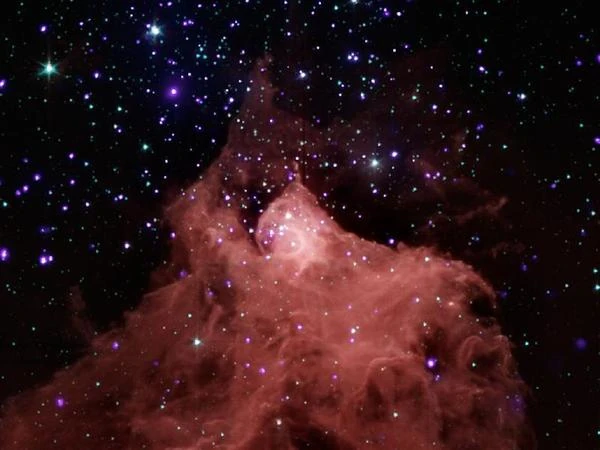
Stars are born in cold, dense regions of the interstellar medium called giant molecular clouds (GMCs). These structures can span several hundred light-years in diameter and contain up to \(10^6\) solar masses of gas, primarily molecular hydrogen (\(\text{H}_2\)), carbon monoxide (\(\text{CO}\)), and interstellar dust.
Gravitational disturbances, such as shock waves from supernovae or cloud collisions, trigger the fragmentation of these regions, promoting the local contraction of matter. Each collapsed fragment is the core of a future star.
Under the influence of gravity, dense cores collapse in on themselves, increasing their central temperature. This process involves a conversion of gravitational energy into thermal energy, according to the Kelvin-Helmholtz mechanism. When the central temperature reaches a few thousand kelvins, the core becomes opaque to infrared radiation, forming a proto-star.
At this stage, the star is enveloped in a protoplanetary disk and a cocoon of gas. Bipolar jets can be emitted perpendicular to the disk, carrying away excess angular momentum and allowing matter to be accreted more efficiently.
When the central temperature reaches about \(10^6\ \text{K}\), hydrogen fusion reactions begin in the core through the proton-proton chain or the CNO cycle, depending on the mass of the proto-star. Radiation pressure then opposes gravitational collapse: the object reaches hydrostatic equilibrium.
The star then enters the main sequence of the Hertzsprung-Russell diagram. Its lifespan strongly depends on its initial mass: a massive star of \(20\ M_\odot\) will shine for only a few million years, while a solar-type star (\(1\ M_\odot\)) will live for about 10 billion years.
Stars are not born in isolation. A single collapsed region can produce hundreds of stars, giving rise to an open cluster. Gravitational interactions between proto-stars in these clusters can form binary or multiple systems. These clusters disperse after a few hundred million years.
The free-fall gravitational collapse time, called the Jeans time, is written as: \( t_J = \sqrt{\frac{3\pi}{32G\rho}} \)
where \(G\) is the gravitational constant and \(\rho\) is the average density of the core. For densities of \(10^{-19}\ \text{kg/m}^3\), we obtain times on the order of a few hundred thousand years.
The Jeans mass defines the mass threshold above which a cloud collapses under its own gravity: \( M_J \approx \left( \frac{5kT}{G\mu m_H} \right)^{3/2} \left( \frac{3}{4\pi \rho} \right)^{1/2} \) where \(T\) is the temperature, \(\mu\) is the average molecular mass, and \(m_H\) is the mass of the hydrogen atom.
It is estimated that the Sun formed 4.6 billion years ago from a core with a typical density \( \rho \approx 10^{-18}\ \text{kg/m}^3 \), temperature \( T \approx 10\ \text{K} \), and composed mainly of \( \text{H}_2 \) with an average molecular mass \( \mu \approx 2.3 \).
➤ Jeans Time:
\[ t_J \approx \sqrt{\frac{3\pi}{32 \times 6.674 \times 10^{-11} \times 10^{-18}}} \approx 1.9 \times 10^{13}\ \text{s} \approx 600,000\ \text{years} \]
➤ Jeans Mass:
\[ M_J \approx \left( \frac{5kT}{G\mu m_H} \right)^{3/2} \left( \frac{3}{4\pi\rho} \right)^{1/2} \]
Using \( k = 1.38 \times 10^{-23}\ \text{J/K} \), \( T = 10\ \text{K} \), \( \mu = 2.3 \), \( m_H = 1.67 \times 10^{-27}\ \text{kg} \), we obtain:
\[ M_J \approx \left( \frac{5 \cdot 1.38 \times 10^{-23} \cdot 10}{6.674 \times 10^{-11} \cdot 2.3 \cdot 1.67 \times 10^{-27}} \right)^{3/2} \cdot \left( \frac{3}{4\pi \cdot 10^{-18}} \right)^{1/2} \approx 1.3\ M_\odot \]
This means that the minimum mass of the solar nebula core had to exceed \( 1.3\ M_\odot \) for gravitational collapse to result in the formation of the Sun. This threshold was likely exceeded in a region compressed by a shock wave from a nearby supernova.
Thus, the Sun formed in about 600,000 years from an unstable core of cold gas, whose mass exceeded the critical mass defined by the Jeans criterion.
The process of star formation is a marvel of balance between gravitational collapse, energy dissipation, accretion, and the initiation of nuclear reactions. Each star is the culmination of a struggle between gravitational attraction and the forces of thermal and radiative pressure, a struggle that begins in the cold, dark depths of giant molecular clouds.